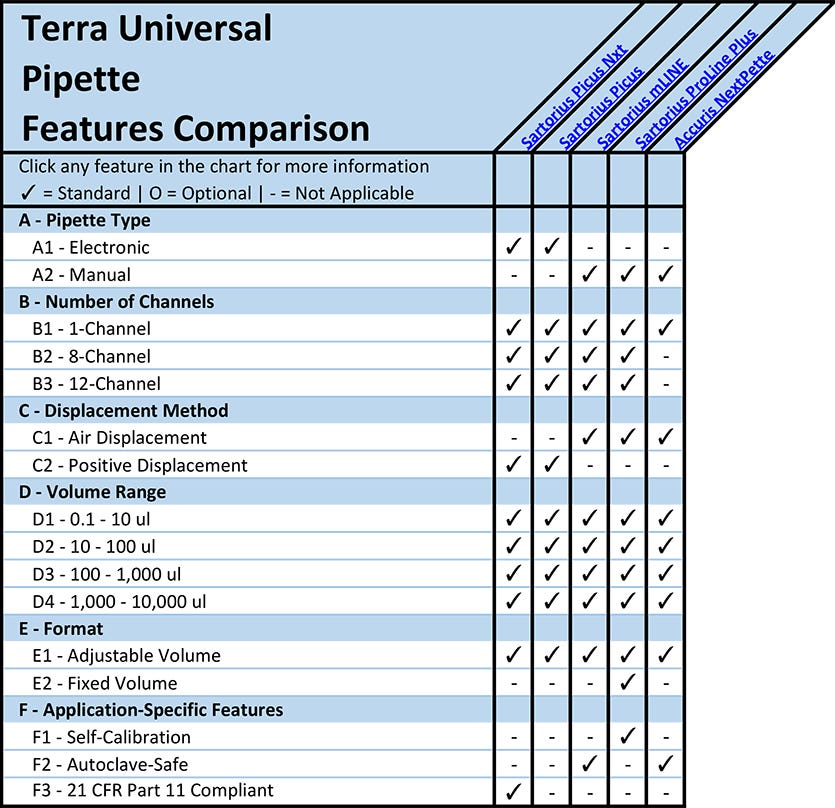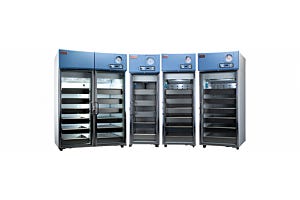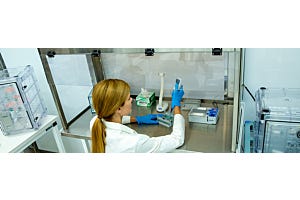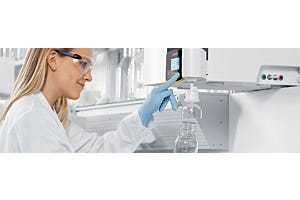
What is a Pipette?
Pipettes are the primary means for transferring liquids, often in milliliter and microliter volumes, into test tubes, microplates, and conical vials for analysis, storage or mixing. Pipettes aspirate a user-selected volume of liquid – samples, reagents, media – from one vessel, then dispense the set volume of liquid into another vessel according to standard operating procedures. Pipettes, or pipettors, are available in a broad range of designs (single-channel or multi-channel), volume ranges, and control systems (mechanical and electronic) for different applications and experience levels.
A - Pipette Type Electronic vs Mechanical Pipettes
(back to chart)
A1 - Electronic Pipettes
Electronic pipettes contain a motor and controller to regulate aspiration and dispensing volumes. Although electronic pipettes cost more than mechanical pipettors, they offer many advantages. Rather than a top-mounted piston-stroke design common in mechanical pipettes, electronic models use front-mounted, ergonomic push-button controls that reduce repetitive strain injuries, air bubbles, and pipette-induced cross-contamination. Electronic pipettes also include programmable software for storage of protocols to optimize experimental set-up and reduce tip usage.
Shop Electronic Pipettes Online
A2 - Mechanical Pipettes
Mechanical pipettes utilize a piston-stroke mechanism, connected to a top-mounted plunger, to drive aspiration and dispensing of liquids. Mechanical models cost significantly less than electronic pipettors, support in-lab calibration, and require limited user training. Prolonged use of mechanical pipettes can, however, lead to repetitive strain injuries, such as pipettor’s thumb, and a reduction in pipetting precision, caused by hysteresis.
B - Number of Pipette Channels
(back to chart)
B1 - 1-Channel Pipettes
Single-channel pipettes are optimal for low-throughput dispensing into flip-cap tubes or conical vials. Single-channel models are less expensive than multi-channel pipettes, easier to calibrate, and small enough to fit into tight spaces, such as analytical instrument sample loading trays.
Shop Single 1 Channel Pipettes
B2 - 8-Channel Pipettes
8-Channel pipettes are ideal for high-throughput dispensing into 96-well microplates or sample troughs. Although 8-channel pipettes are more expensive than single-channel models, they dispense liquid into 8 wells at a time, supporting more efficient loading of microplates for serial dilutions, reagent dispensing, and quality control sample analysis.
B3 - 12-Channel Pipettes
12-channel pipettes are optimal for high-throughput dispensing into 96-well or 384-well microplates or reagent reservoirs. For protocols directing row-based, rather than column-based, plate loading, 12-channel models are more efficient than 8-channel pipettes.
C - Pipette Displacement Method
(back to chart)
C1 - Air Displacement Pipettes
Air displacement pipettes contain a piston that moves up to take in air during aspiration and moves down to expel air during dispensing. The amount of air displaced is equal to the volume of liquid aspirated or dispensed. Air displacement pipettes are ideal for transferring aqueous samples, such as reagents, buffer, media, nucleic acids and proteins.
Shop Air Displacement Pipettes
C2 - Positive Displacement Pipettes
Positive displacement pipettes contain a capillary and piston, which is loaded into the pipette tip and thus in direct contact with the sample. Since there isn’t an air channel between the piston and the sample, positive displacement pipettes achieve a more consistent dispensing force, making them ideal for viscous and volatile samples, such as glycerol, ethanol and radionuclides.
E - Pipette Volume and Flow Rate Adjustment
(back to chart)
E1 - Adjustable Volume Pipettes
Adjustable volume pipettes regulate aspiration and dispensing volume to a specified range. Adjustable pipettes are available with either mechanical dials or electronic controls; adjustment increments vary by pipette brand and model. The added flexibility of an adjustable-volume pipette is ideal for research labs and contract manufacturers with ever-shifting protocols.
E2 - Fixed Volume Pipettes
Fixed volume pipettes dispense a singular volume of liquid repeatedly. As these workhorse models contain fewer moving parts, fixed-volume pipettes require infrequent calibration. More economical than adjustable-volume models, fixed-volume pipettors are optimal for production environments with concrete standard operating procedures.
Shop Pipettes with Volume and Flow Features
F - Pipette Applications and Features
(back to chart)
F1 - Self-Calibration Pipettes
The Sartorius ProLine Plus Pipette contains a self-calibration system allowing lab personnel to test and re-calibrate pipettes without an on-site service technician. Removing the calibration nut located on the back of the pipette handle exposes a volume-adjustment lock. The calibration tool is inserted into the adjustment lock and turned to increase or decrease the aspiration and dispensing volume. Once the appropriate volume is achieved, the volume is validated through performance testing using an analytical balance.
Shop Electronic Pipette Controllers
F2 - Autoclave-Safe Pipettes
For thorough pipette decontamination, certain models are manufactured from materials compatible with a standard autoclave routine (121 degrees Celsius in 20 minutes).
F3 - 21 CFR Part 11 Compliant Pipettes
Ideal for 21 CFR Part 11 facilities, the Sartorius Picus NxT electronic pipette includes data export functionality, password-protected saved programs and event tracking.
Where Can I Find a Trusted Supplier of Pipettes and Other Laboratory Equipment?
Laboratory-Equipment.com offers carefully selected pipettes and equipment for a range of applications including PCR, DNA/RNA techniques, ELISA, protein analysis, and cell culture. Through our worldwide network of reps, we supply some of the largest research and production facilities in the world. Laboratory-Equipment.com is a laboratory specialty division of Terra Universal. For nearly 40 years, Terra has served semiconductor, aerospace, life science, pharmaceutical, biotechnology, and medical device markets.















